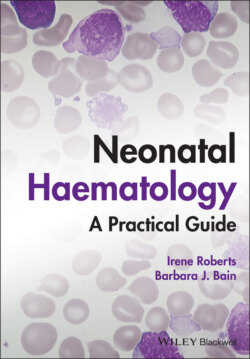Читать книгу Neonatal Haematology - Barbara J. Bain, Irene Roberts - Страница 37
Platelet numbers in the neonate and fetus – normal values
ОглавлениеSince platelet counts in fetal blood reach normal adult values by the end of the second trimester, it is reasonable to consider that platelet counts of less than 150 × 109/l represent thrombocytopenia in a healthy neonate regardless of gestation at birth. This conclusion has been challenged by a large retrospective analysis of 47 000 neonates, in which a reference range of platelet counts at different gestational ages was determined by excluding the highest and lowest 5th percentile of all observed counts. By this method, the lowest limit of platelet counts was found to be 104 × 109/l for infants of less than 32 weeks’ gestation, compared with 123 × 109/l for neonates of greater than 32 weeks’ gestation.146 However, as the study included all neonates, regardless of clinical status, these counts may simply reflect the high frequency of thrombocytopenia in neonatal units, where sepsis and placental insufficiency are common causes for admission, rather than representing a new physiological definition of normal platelet counts in the newborn. Indeed, the mean platelet count was above 200 × 109/l regardless of gestation at birth, consistent with accepted normal ranges for the platelet count in neonates.143
Several studies have investigated the clinical relevance of newer automated platelet parameters in neonatal medicine, particularly the immature platelet fraction (IPF). Overall, these studies support the conclusion that in neonates, as in adults, the IPF% provides a measure of the proportion of immature platelets and a surrogate measure of platelet production although the results are variable.147 MacQueen and colleagues established reference ranges for the IPF% in their hospitals based on more than 20 000 automated results from nearly 9000 neonates.148 They reported a higher IPF% in the most premature infants (less than 32 weeks’ gestation). Consistent with this, they also found that IPF% values were higher in neonates who developed consumptive thrombocytopenia compared with those were considered to have reduced platelet production, suggesting that further clinical studies of the value of the IPF% in neonates might be useful, given the practical difficulties of bone marrow aspiration in the newborn.
